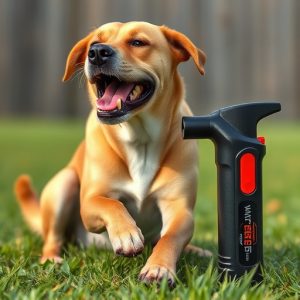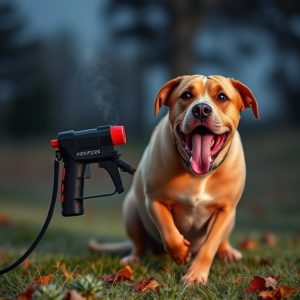Runners’ Safety: Dog Deterrent Sprays, Legalities, and Pet Protection
Self-defense spray for pets and runners is popular but must be used within local Self Defense Spray…….
Self-defense spray for pets and runners is popular but must be used within local Self Defense Spray Regulations for pets, which vary widely. Laws restrict spray use against animals after exhausting non-lethal methods, ensuring pet safety and community well-being. While effective, self-defense spray should be a last resort after proper training and avoiding aggressive encounters, as it may not deter all assailants. Always check local rules regarding possession and application for comprehensive pet protection.
Runners often face unique challenges when it comes to personal safety, especially during early morning or evening jogs. One effective tool gaining popularity is dog deterrent spray, which can serve as a powerful self-defense mechanism. This article explores the world of self-defense spray for runners, delving into legal considerations and regulations surrounding its use. We’ll also discuss the role of pets in deterring crime and provide insights on choosing and using dog deterrent sprays responsibly while adhering to Self Defense Spray Regulations and keeping pets involved.
- Understanding Self-Defense Spray: Legalities and Regulations
- The Role of Pets in Deterring Criminal Activity
- Effective Dog Deterrent Sprays for Runners' Safety
- Considerations and Best Practices for Using Self-Defense Spray with Pets
Understanding Self-Defense Spray: Legalities and Regulations
Self-defense spray for runners is a popular tool designed to protect against potential threats while outdoor activities. However, understanding its legalities and regulations is crucial before considering it as a pet deterrent. The use of self-defense spray is governed by local laws, which vary widely across regions. It’s essential to check your area’s specific rules regarding the possession, carrying, and application of such devices, especially when in public spaces.
In many places, self-defense spray is legal for personal protection, but restrictions apply when used against animals or pets. Some jurisdictions have specific regulations targeting animal deterrents, aiming to protect both wildlife and domestic animals from indiscriminate use of force. These regulations often require users to exhaust other non-lethal methods before employing spray and may limit its range and strength to minimize harm. Pet owners should ensure they comply with these Self Defense Spray Regulations for the safety of their pets and the broader community.
The Role of Pets in Deterring Criminal Activity
In many communities, pets play an unexpected yet significant role in deterring criminal activity. From barking loudly to alert owners or neighbors of potential intruders, dogs in particular have long been considered as a form of natural security system. Their keen senses and loyalty make them excellent watchdogs, capable of scaring off potential thieves or intruders with their loud barks and intimidating presence.
Moreover, the use of self-defense spray, including dog deterrent sprays, has gained traction as a means to protect both pets and their owners. These non-lethal sprays are designed to incapacitate an intruder temporarily without causing severe harm, giving residents valuable time to escape or call for help. With proper training and regulation in place, pet owners can leverage their furry companions’ protective instincts while adhering to local self-defense spray regulations, thereby enhancing overall security measures within the community.
Effective Dog Deterrent Sprays for Runners' Safety
For runners, encountering aggressive dogs can be a frightening experience. Fortunately, self-defense spray designed to deter canine attackers has emerged as a valuable tool for enhancing runner safety. These specialized sprays contain capsaicin, the active ingredient found in chili peppers, which irritates a dog’s eyes and respiratory system when inhaled. This temporary but intense irritation often causes dogs to retreat, allowing runners to escape unharmed.
When considering self-defense spray for protection while running, it’s crucial to understand local regulations regarding pet control and the use of such products. Some areas have strict rules about carrying pepper spray, especially in public spaces where pets are allowed. Always check with your local authorities to ensure compliance with relevant laws. Additionally, opt for sprays designed specifically for dog deterrence, ensuring they are effective against canine aggression without causing harm to other animals or humans.
Considerations and Best Practices for Using Self-Defense Spray with Pets
When considering self-defense spray for your pets, it’s crucial to understand the regulations surrounding its use. Different regions have varying laws and restrictions on the type and possession of pepper spray or other personal defense aerosols, especially when used on animals. Always check local ordinances before purchasing and using any self-defense spray.
Best practices dictate that self-defense spray should be a last resort for protecting your pets from dangerous situations. It’s important to train your pets to respond calmly to commands and avoid aggressive encounters. Regularly updating their training and socialization ensures they remain well-behaved, reducing the likelihood of needing to deploy spray. Additionally, keep in mind that self-defense spray may not always be effective against larger or more determined assailants, so a multi-layered defense approach is ideal for comprehensive pet protection.
Runners looking to enhance their personal safety while out on trails or in urban areas can consider dog deterrent sprays as a viable self-defense option. However, it’s crucial to understand and adhere to local regulations regarding the use of such sprays, especially when pets are involved. By choosing effective, pet-friendly formulations and employing best practices, runners can leverage their furry companions’ protective instincts while navigating legal boundaries, ultimately fostering a safer environment for both humans and their canine friends.


